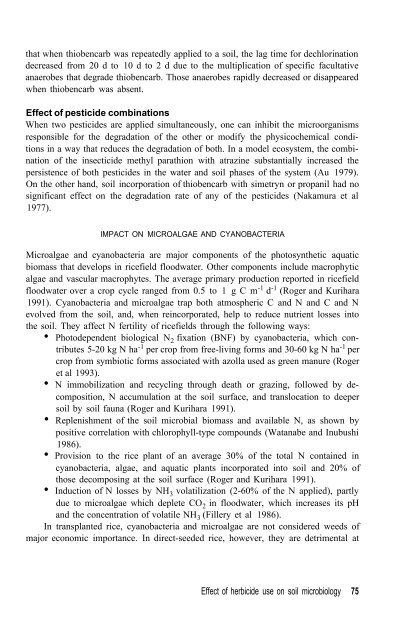HERBICIDES in Asian rice - IRRI books - International Rice ...
HERBICIDES in Asian rice - IRRI books - International Rice ...
HERBICIDES in Asian rice - IRRI books - International Rice ...
Create successful ePaper yourself
Turn your PDF publications into a flip-book with our unique Google optimized e-Paper software.
that when thiobencarb was repeatedly applied to a soil, the lag time for dechlor<strong>in</strong>ation<br />
decreased from 20 d to 10 d to 2 d due to the multiplication of specific facultative<br />
anaerobes that degrade thiobencarb. Those anaerobes rapidly decreased or disappeared<br />
when thiobencarb was absent.<br />
Effect of pesticide comb<strong>in</strong>ations<br />
When two pesticides are applied simultaneously, one can <strong>in</strong>hibit the microorganisms<br />
responsible for the degradation of the other or modify the physicochemical conditions<br />
<strong>in</strong> a way that reduces the degradation of both. In a model ecosystem, the comb<strong>in</strong>ation<br />
of the <strong>in</strong>secticide methyl parathion with atraz<strong>in</strong>e substantially <strong>in</strong>creased the<br />
persistence of both pesticides <strong>in</strong> the water and soil phases of the system (Au 1979).<br />
On the other hand, soil <strong>in</strong>corporation of thiobencarb with simetryn or propanil had no<br />
significant effect on the degradation rate of any of the pesticides (Nakamura et al<br />
1977).<br />
IMPACT ON MICROALGAE AND CYANOBACTERIA<br />
Microalgae and cyanobacteria are major components of the photosynthetic aquatic<br />
biomass that develops <strong>in</strong> <strong>rice</strong>field floodwater. Other components <strong>in</strong>clude macrophytic<br />
algae and vascular macrophytes. The average primary production reported <strong>in</strong> <strong>rice</strong>field<br />
floodwater over a crop cycle ranged from 0.5 to 1 g C m -1 d -1 (Roger and Kurihara<br />
1991). Cyanobacteria and microalgae trap both atmospheric C and N and C and N<br />
evolved from the soil, and, when re<strong>in</strong>corporated, help to reduce nutrient losses <strong>in</strong>to<br />
the soil. They affect N fertility of <strong>rice</strong>fields through the follow<strong>in</strong>g ways:<br />
• Photodependent biological N 2 fixation (BNF) by cyanobacteria, which contributes<br />
5-20 kg N ha -1 per crop from free-liv<strong>in</strong>g forms and 30-60 kg N ha -1 per<br />
crop from symbiotic forms associated with azolla used as green manure (Roger<br />
et al 1993).<br />
• N immobilization and recycl<strong>in</strong>g through death or graz<strong>in</strong>g, followed by decomposition,<br />
N accumulation at the soil surface, and translocation to deeper<br />
soil by soil fauna (Roger and Kurihara 1991).<br />
• Replenishment of the soil microbial biomass and available N, as shown by<br />
positive correlation with chlorophyll-type compounds (Watanabe and Inubushi<br />
1986).<br />
• Provision to the <strong>rice</strong> plant of an average 30% of the total N conta<strong>in</strong>ed <strong>in</strong><br />
cyanobacteria, algae, and aquatic plants <strong>in</strong>corporated <strong>in</strong>to soil and 20% of<br />
those decompos<strong>in</strong>g at the soil surface (Roger and Kurihara 1991).<br />
• Induction of N losses by NH 3 volatilization (2-60% of the N applied), partly<br />
due to microalgae which deplete CO 2 <strong>in</strong> floodwater, which <strong>in</strong>creases its pH<br />
and the concentration of volatile NH 3 (Fillery et al 1986).<br />
In transplanted <strong>rice</strong>, cyanobacteria and microalgae are not considered weeds of<br />
major economic importance. In direct-seeded <strong>rice</strong>, however, they are detrimental at<br />
Effect of herbicide use on soil microbiology 75

















